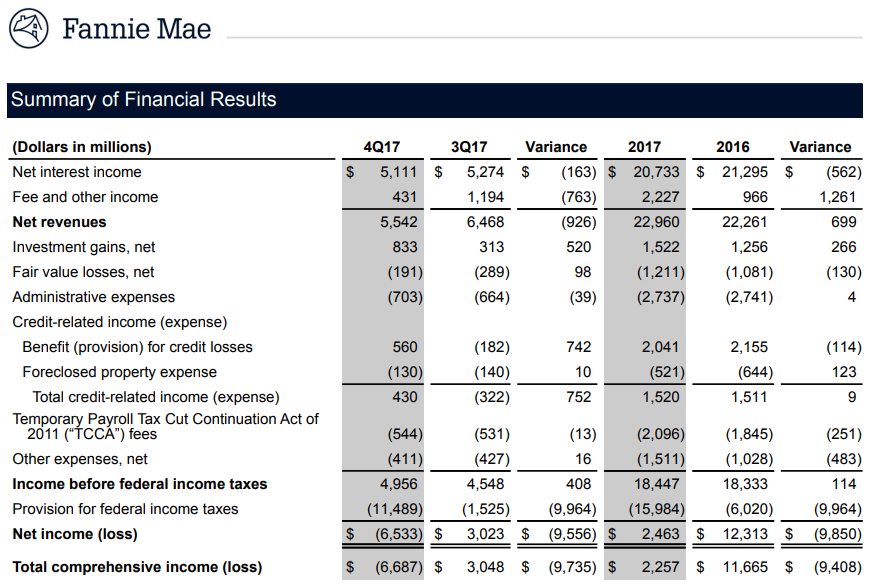Due to accounting losses stemming from the tax legislation signed into law late last year, Fannie Mae has a deficit of $3.7 billion and will now require funding in that amount from the U.S. Treasury.
In the third quarter of 2017, the enterprise had a net income of $3 billion, but in the fourth quarter it posted a net loss of $6.5 billion. The total comprehensive loss was $6.7 billion last quarter, thereby creating a $3.7 billion deficit. Fannie Mae says the primary driver of the drop-off was a $9.9 billion provision for federal income taxes in the fourth quarter resulting from the remeasurement of the company’s deferred tax assets due to the Tax Cuts and Jobs Act (Tax Act).
Previously, Fannie and other institutions had been able to use past losses to offset future profits and cut their tax bills, a recent report from Fitch Ratings explains. Since tax rates have been lowered, those deferred tax assets are now worth less.
The Fitch report also notes that Fannie’s deferred tax assets far exceed its net income. Through September 2016, the enterprise’s deferred tax assets totaled $35.1 billion and its year-to-date net income was $7.3 billion.
In 2017, Fannie’s net income was $2.5 billion, down from $12.3 billion in 2016.
Multifamily Record
On the multifamily side of the business, Fannie saw its new multifamily business volume increase from about $16 billion in the third quarter of 2017 to more than $20 billion in the fourth quarter.
Fannie provided more than $67 billion in multifamily and other rental financing and supported 770,000 units of multifamily housing in 2017, the highest multifamily rental volume in the history of the government-sponsored enterprise's Delegated Underwriting and Servicing (DUS) program.
To eliminate the company’s net worth deficit, Fannie says it expects the director of the Federal Housing Finance Agency (FHFA) will submit a request to Treasury on its behalf for $3.7 billion.
Looking ahead, Fannie expects to remain profitable on an annual basis for the foreseeable future, though nothing is certain. “Our 2017 results demonstrate that the fundamentals of our business are strong,” said Timothy J. Mayopoulos, Fannie’s president and CEO, in a statement. “While the fourth quarter was affected by a one-time accounting charge, we expect to benefit from a lower tax rate going forward.”
The company’s pre-tax income of $18.4 billion last year was up from $18.3 billion in 2016.
Here’s more from Fannie:
The potential for significant volatility in the company’s financial results could result in a net loss in a future quarter. Because the company had a net worth deficit as of Dec. 31, 2017, it has no remaining capital reserves as of that date. Pursuant to the December 2017 letter agreement … Fannie Mae is now permitted to retain up to $3 billion in future earnings as capital reserves. Once the company is able to rebuild its capital reserves to $3 billion, the capital reserves will provide a buffer in the event of a net loss in a future quarter. However, any net loss the company experiences in the future could be greater than the amount of its capital reserves. If this were to occur, it would result in a net worth deficit for that quarter. If the company has another net worth deficit in a future quarter, it will be required to draw additional funds from Treasury under the senior preferred stock purchase agreement to avoid being placed into receivership.
